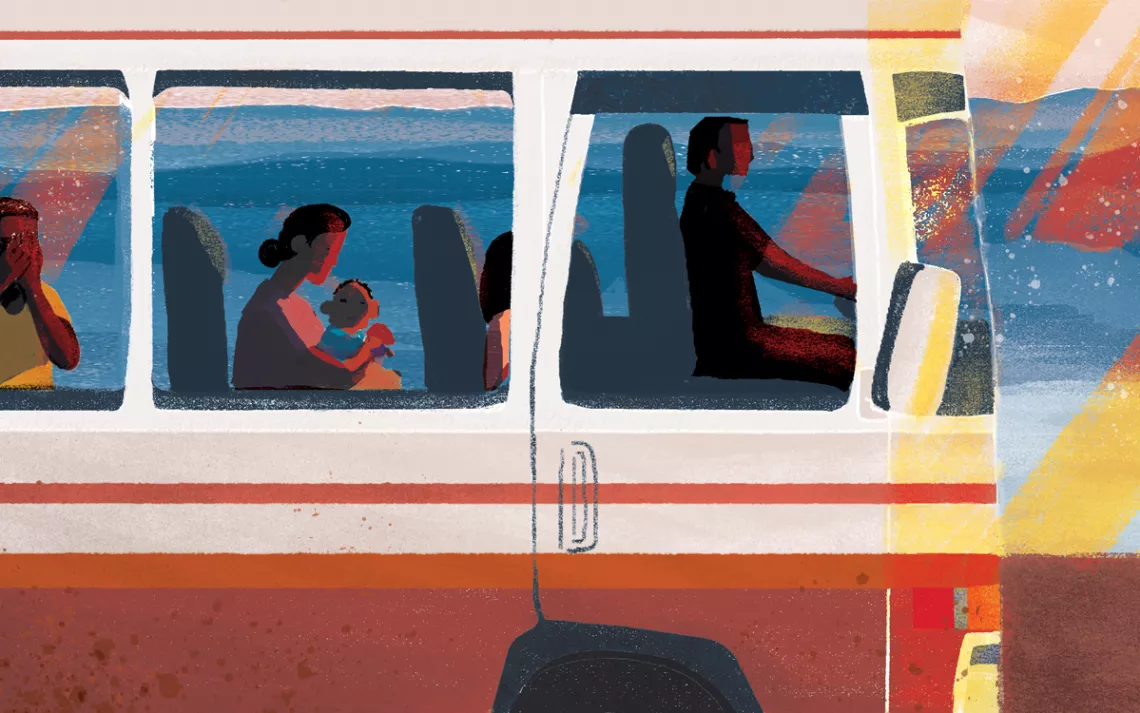*This* Close to a Bus Plunge in Myanmar
Now I know why my fellow passengers prayed before we left

Illustration by LA Johnson
The bus ride to Hakha, a city in Myanmar's northern Chin State, begins with a prayer for a safe journey. It's just after dawn on a drizzly gray Monday in the provincial border city of Kale. I was supposed to leave the day before, but although Myanmar is a predominantly Buddhist nation, Chin is a Christian state, so no buses depart on Sunday.
Eleven of us on the bus bow our heads in prayer. There are two men who have claimed the back row, four women, and one very happy baby, who, over the course of the ride, will be passed around to spread her joy. I am the only foreigner, because Hakha isn't on the tourist trail. I'm not a tourist, though. I'm here to report on climate change.
I have been in Myanmar for five days, and I am traveling alone. My brain, fogged by erratic sleep and the task of processing so much newness, has defaulted to passivity. I observe much, question little. The prayer strikes me as unusual, though—when was the last time a Greyhound bus ride began with a prayer?
As I sit in this cramped minibus, head bowed, a thick wash of memory rolls over me: of my Catholic school days, of yellow school buses, of rituals like this. Hours later, I realize that the prayer wasn't ritual; it was insurance.
On maps the road is a thin ribbon snaking along the Chin Hills, taking us up to 7,000 feet, down to 1,000 feet, then back up again in a meandering roller coaster. Although badly deforested, Chin State still appears lush. There are beautiful—if young—forests, waterfalls, and tiny towns with homes built on stilts, dangling off the sides of cliffs.
Google says the 110-mile trip will take three hours and 49 minutes. Locals say seven hours. In the end it takes 11. At some points the holes and crevices occupy more surface than the road itself.
The bus bumps and lurches, and my knuckles ache from gripping the seat. There are no seat belts. The road is designated for two-way traffic, but it's only wide enough for one and a half. We honk aggressively around blind turns and slow down when the road puts us within inches of its edge. There are no guardrails.
Because of deforestation, when it rains the road is buried under waves of rock and soil. Climate change is causing erratic and intense rainfall and thus more road damage. Seven hours in, the bus plows through what the driver thinks is a puddle but is really a deep pothole. A large rock at its bottom gets wedged behind a wheel, jolting us to a stop.
Behind us forms a line of cars and buses that can't squeak past. Eventually a rope is procured and we are towed out. We are going up again, higher into the mist-ringed mountains. I notice that the mileage markers resemble gravestones. The baby falls asleep. Taking her cue, I do the same.
It's the screaming that wakes me up. The road is veering toward the right. Despite the driver's best effort, the bus is not. Something must have broken back there in the pothole. We can no longer turn right and are heading off the road, which is to say off the mountain. A friend who'd worked in Myanmar told me that when a person dies in public here, photos of their dead body often surface on social media. I'm thinking, "I don't want to end up on Myanmar Facebook" as the bus stops a foot from the cliff's edge.
The bus is finished. I make it to Hakha in an SUV that another passenger flags down. I wonder if I can use my travel insurance to helicopter out. Then I realize that this is everyday life for people here. I'd come to observe climate change's impacts; the road forced me to actually experience them. I pray. I take the road back out. I do not end up on Myanmar Facebook.
This article appeared in the September/October 2017 edition with the headline "The Road to Hakha."
 The Magazine of The Sierra Club
The Magazine of The Sierra Club



